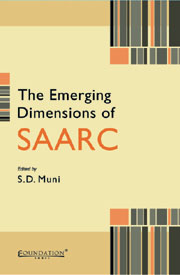Book contents
- Frontmatter
- Contents
- Preface
- List of Figures
- List of Tables
- 1 SAARC Prospects: The Changing Dimensions
- 2 SAARC and South Asian Economic Integration
- 3 Coping with the Emerging Challenges: Poverty and Food Security
- 4 SAARC Energy Cooperation: Energy Security and Environmental Challenges
- 5 Sub-Regional Cooperation under SAARC: An Economic Analysis
- 6 SAARC: Social Charter and Human Security
- 7 SAARC and the South Asian Security Architect
- 8 Fighting Terrorism through SAARC?
- 9 SAARC and the Evolving Asian Regionalism
- 10 Role of SAARC Observers: Members' Perspectives
- 11 Role of SAARC Observers: Observers' Perspectives
- 12 Concluding Remarks
- About the Contributors
- Index
2 - SAARC and South Asian Economic Integration
Published online by Cambridge University Press: 26 October 2011
- Frontmatter
- Contents
- Preface
- List of Figures
- List of Tables
- 1 SAARC Prospects: The Changing Dimensions
- 2 SAARC and South Asian Economic Integration
- 3 Coping with the Emerging Challenges: Poverty and Food Security
- 4 SAARC Energy Cooperation: Energy Security and Environmental Challenges
- 5 Sub-Regional Cooperation under SAARC: An Economic Analysis
- 6 SAARC: Social Charter and Human Security
- 7 SAARC and the South Asian Security Architect
- 8 Fighting Terrorism through SAARC?
- 9 SAARC and the Evolving Asian Regionalism
- 10 Role of SAARC Observers: Members' Perspectives
- 11 Role of SAARC Observers: Observers' Perspectives
- 12 Concluding Remarks
- About the Contributors
- Index
Summary
Introduction
SAARC was an initiative conceptualised by the then President of Bangladesh Ziaur Rahman who envisioned a trade bloc consisting of South Asian countries. The countries in South Asia had a long common historical heritage, and until the middle of the last century, movements of goods and people across the region was taken for granted. Trade flourished through these traditional movements, and the common ethnicity of the region, the congruence of consumption patterns and daily habits, provided a natural incentive to trade across different regions in South Asia.
The inter-regional commonalities in consumption behaviour as well as social practices continue even to date. Food habits in the southern districts of Tamil Nadu and Kerala resemble those in Sri Lanka very closely. Attire and clothing is very similar, and there are several social practices that are identical. West Bengal and Bangladesh share common cuisines and habits, and there is considerable similarity in the two Punjabs. It is therefore natural to expect that there should be free flow of goods and services across these regions. There is more in common between the two Punjabs than there is between Punjab and Kerala. Economic integration of the South Asian countries should have been a natural phenomenon, not an exception. Therefore the concept of regional trading block that would encompass the South Asian countries, most of which had been part of a unified administration until 1947, was recognition of the inherent historical advantages of regional trade and development.
- Type
- Chapter
- Information
- The Emerging Dimensions of SAARC , pp. 32 - 50Publisher: Foundation BooksPrint publication year: 2010
- 1
- Cited by



